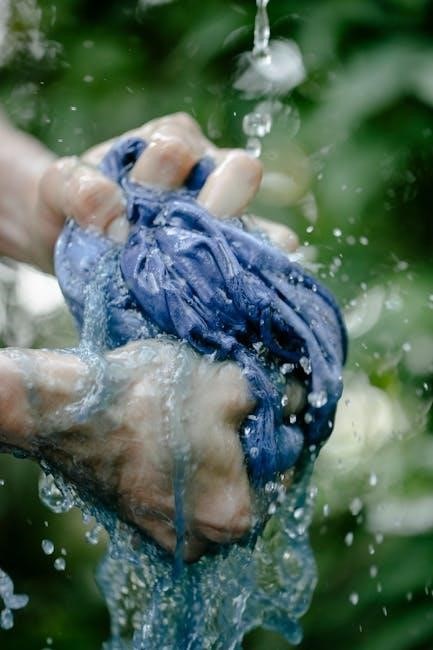
The DIG Water Timer is an innovative electronic device designed to automate watering schedules, ensuring efficient water use and healthy plant growth, offering convenience and customization for gardeners.

1.1 Overview of the DIG Water Timer
The DIG Water Timer is a user-friendly, electronic device designed to automate watering schedules for gardens, lawns, and irrigation systems. Built with durable materials, it offers precise control over water distribution, ensuring efficient use of resources. The timer is compatible with various water systems and can be programmed to meet specific needs, whether for residential or commercial use. Its intuitive interface and customizable settings make it an ideal solution for maintaining healthy plant growth while conserving water. Designed for ease of installation and operation, the DIG Water Timer is a versatile tool for gardeners and professionals alike.
1.2 Importance of Proper Watering
Proper watering is essential for plant health, as overwatering can lead to root rot and underwatering may cause stress. The DIG Water Timer ensures precise water delivery, promoting healthy growth and preventing waste. By automating schedules, it maintains consistent moisture levels, reducing the risk of plant diseases. This precision also supports water conservation, making it an eco-friendly solution for gardeners. Proper watering enhances soil quality and root development, ensuring plants thrive in optimal conditions. The timer’s accuracy helps avoid common watering mistakes, making it a valuable tool for both experienced gardeners and newcomers.
1.3 Benefits of Using a Water Timer
Using a water timer offers numerous advantages, including consistent watering schedules, reduced water waste, and healthier plants. It allows for precise control over watering duration and frequency, ensuring optimal hydration without overwatering. This convenience saves time and effort, especially for busy individuals. Additionally, it promotes water conservation by automating the process and preventing unnecessary usage. The timer also helps maintain soil health by delivering water evenly, which supports robust plant growth. Overall, it’s a practical solution for gardeners seeking efficiency, sustainability, and ease in their watering routines.
Unboxing and Initial Setup
Upon unboxing, ensure all components are included. Install batteries or charge the timer. Read the manual for initial setup instructions, and familiarize yourself with the display and controls.

2.1 What’s Included in the Package
The DIG Water Timer package includes the timer unit, a mounting bracket, a 3/4″ hose connector, two 1/2″ hose connectors, a battery compartment, and a user manual. Additionally, it comes with a quick-start guide and warranty information. The timer is pre-equipped with alkaline batteries for immediate use. All components are designed for easy installation and compatibility with standard water systems. The package ensures everything needed for setup is included, providing a seamless experience for users to begin automating their watering schedules efficiently.

2.2 Preparing the Timer for First Use
Before using the DIG Water Timer, ensure all components are included and undamaged. Insert the provided batteries, making sure they are correctly oriented. Power on the timer and set the current date and time. Familiarize yourself with the display and button functions. Read the manual to understand basic operations. Test the timer by running a short cycle to confirm proper function. Ensure the timer is clean and dry before installation. Proper preparation ensures smooth operation and extends the product’s lifespan. Always follow the manufacturer’s guidelines for initial setup.
2.3 Understanding the Display and Buttons
The DIG Water Timer features an intuitive LCD display that shows the current time, scheduled watering times, and battery status. The display is backlit for visibility in low light. Below it, you’ll find a set of buttons: UP and DOWN for adjusting values, LEFT and RIGHT for navigating menus, and a SELECT button to confirm choices. The MANUAL button overrides schedules for one-time watering, while the ON/OFF button controls power. These buttons are designed for easy operation, allowing users to quickly set up and adjust watering schedules. Proper use ensures efficient and precise water management for your plants.

Installation and Mounting
The DIG Water Timer is easily installed and mounted, ensuring a secure connection to your faucet and proper integration with your watering system for optimal performance.
3.1 Choosing the Right Location
Choosing the right location for your DIG Water Timer is crucial for optimal performance and durability. Ensure the timer is installed in an area protected from direct sunlight, heavy rain, and extreme temperatures. It should be near a power source if required and within easy reach for programming and maintenance. Avoid areas prone to flooding or moisture accumulation. The location should also provide clear visibility of the display for convenient monitoring. Proper placement ensures the timer functions efficiently and lasts longer, while also maintaining ease of access for adjustments and troubleshooting.
3.2 Mounting the Timer to a Faucet
Mounting the DIG Water Timer to your faucet is a straightforward process that ensures precise control over water flow. Begin by attaching the timer to the faucet using the provided adapter, ensuring a secure, leak-free connection. Align the timer’s inlet and outlet ports with the faucet’s threads, then gently tighten by hand or with an adjustable wrench. Once mounted, double-check the connection for stability and proper alignment. Finally, test the system by running water through it to confirm everything is functioning correctly and there are no leaks.
3.3 Connecting the Timer to Your Water System
To connect the DIG Water Timer, first attach it to your faucet using the provided adapters, ensuring compatibility with your faucet size. Next, secure the timer firmly to prevent leaks. Connect the inlet hose to the water source and the outlet hose to your watering system. Tighten all connections by hand or with a wrench to avoid over-tightening. Turn the water supply on slowly to check for leaks. Once connected, test the system by running a manual cycle to ensure proper water flow and timer operation. This ensures efficient and precise watering control for your plants.
Programming the DIG Water Timer
Program the timer by setting the clock, configuring watering schedules, selecting manual or automatic modes, and customizing watering duration and frequency to suit your needs precisely.
4.1 Setting the Clock and Date
Accurately setting the clock and date on your DIG Water Timer is essential for proper scheduling. Begin by inserting the batteries or connecting power. Use the navigation buttons to access the clock settings. Select the current time and date, ensuring the format matches your preferences. Save the settings to synchronize the timer with your watering schedule. This step ensures all programmed watering cycles occur at the correct times. For detailed button functions, refer to the manual or on-screen prompts. Proper setup guarantees efficient and precise water management for your plants. Regularly check and update the clock during daylight saving changes or power outages to maintain accuracy.
4.2 Configuring Watering Schedules
Configuring watering schedules on the DIG Water Timer allows for precise control over irrigation. Use the SET and +/- buttons to select start times, duration, and frequency. Choose between daily, every other day, or specific days of the week. For multiple schedules, repeat the process for each desired time. The timer also supports seasonal adjustments, enabling you to adapt watering cycles to weather changes. Ensure the schedule aligns with plant needs and soil type for optimal results. This feature promotes water efficiency and reduces waste, making it ideal for both small gardens and larger landscapes.
4.3 Setting Up Manual and Automatic Modes
The DIG Water Timer offers both manual and automatic modes for flexible watering control. In manual mode, users can activate watering sessions on demand, ideal for occasional adjustments. Automatic mode allows the timer to follow a preset schedule, ensuring consistent watering without manual intervention. To switch modes, press and hold the mode button until the indicator light changes. Ensure the timer is properly programmed for automatic mode to function correctly. This dual-mode feature provides convenience and adaptability, catering to different watering needs and preferences, while maintaining efficient water usage and plant care.
4.4 Customizing Watering Duration and Frequency
Customizing watering duration and frequency on the DIG Water Timer allows for precise control over irrigation schedules. Users can adjust the duration from 1 minute to 12 hours and set frequencies from daily to weekly intervals. The timer’s interface provides intuitive buttons for increasing or decreasing these settings. For example, press the “+” or “-” buttons to modify duration in 1-minute increments. Frequency can be adjusted using the “Frequency” button, cycling through options like “Daily,” “Every 2 Days,” or “Weekly.” This flexibility ensures optimal watering for various plant types and soil conditions, promoting healthy growth while conserving water. Always test settings to confirm accuracy.

Advanced Features of the DIG Water Timer
The DIG Water Timer offers advanced features like rain delay, seasonal adjustments, and smart app integration, enabling precise control and customization for optimal watering management and efficiency.
5.1 Rain Delay and Rain Sensor Compatibility
The DIG Water Timer offers a rain delay feature, allowing you to pause watering for a set period after rainfall. It is compatible with rain sensors, which detect moisture levels and automatically adjust watering schedules. This integration ensures water is conserved and plants receive the right amount of moisture. The timer can be programmed to extend the next watering cycle based on rain detection, preventing overwatering. This feature is optional and can be enabled or disabled depending on your specific needs, making it a versatile solution for efficient watering management.
5.2 Seasonal Adjustments for Watering
Seasonal adjustments are crucial for optimizing water usage and plant health. During spring, increase watering frequency as plants grow actively. In summer, extend duration due to higher evaporation. Reduce watering in fall as plants become dormant. In winter, minimize sessions to prevent overwatering. The DIG Water Timer allows customization of schedules based on seasonal needs, ensuring plants receive the right amount of water year-round. This feature prevents overwatering and underwatering, promoting healthy growth while conserving water. Adjustments are easily made via the timer’s interface, adapting to changing weather and plant requirements.
5.3 Remote Control and Smart App Integration
The DIG Water Timer offers seamless integration with smart home systems, allowing users to control watering schedules remotely via a dedicated app. Compatible with popular smart devices, it enables voice commands through smart speakers for hands-free operation. The app provides real-time monitoring, letting users adjust settings, view schedules, and receive notifications. This feature enhances convenience, ensuring optimal watering even when away from home. Remote access simplifies management, while smart integration boosts efficiency and customization for tailored watering solutions.

Maintenance and Troubleshooting
Regularly clean the timer to prevent blockages and ensure smooth operation. Check and replace batteries as needed to maintain functionality. Address common issues like leaks or display malfunctions promptly for optimal performance.
6.1 Cleaning the Timer and Its Components
Regular cleaning of the DIG Water Timer ensures optimal performance and longevity. Use a soft, dry cloth to wipe the exterior, removing dirt or debris. For tougher stains, dampen the cloth with mild soap solution, but avoid harsh chemicals. Internal components, such as the water filter and sensors, should be cleaned with a small brush or toothbrush to remove mineral buildup or sediment. Disconnect power before cleaning internal parts. Rinse with distilled water to prevent mineral spots. Allow all components to dry completely before reassembling. Cleaning after each watering season is recommended to maintain efficiency and prevent corrosion. Schedule regular maintenance for best results.
6.2 Replacing Batteries and Power Management
To ensure uninterrupted operation, replace the batteries when the low-battery indicator appears. Open the battery compartment, remove the old batteries, and insert new ones of the recommended type (e.g., alkaline). Ensure correct polarity to avoid damage. After replacing, close the compartment securely. For optimal performance, avoid mixing old and new batteries. Store spare batteries in a cool, dry place. If using rechargeable batteries, follow the manufacturer’s charging instructions. Regularly check battery levels and replace them every 2-3 years or as needed. Proper power management extends the timer’s lifespan and reliability.
6.3 Common Issues and Solutions
Common issues with the DIG Water Timer include display malfunctions, water not turning on, or incorrect scheduling. For display issues, restart the timer or replace batteries. If water doesn’t turn on, check valve connections and ensure proper installation. For scheduling errors, reprogram the timer and verify settings. Leaks may occur due to loose connections; tighten all fittings. Always refer to the manual for troubleshooting steps. Regular maintenance, like cleaning sensors and updating software, can prevent many issues. Ensure proper power management and seasonal adjustments for optimal performance. Addressing these common problems ensures efficient and reliable operation of the timer.
Watering Best Practices
Optimize watering by understanding soil types, plant needs, and climate. Avoid overwatering, use sensors, and maintain consistent schedules to promote healthy growth and water conservation effectively always.
7.1 Determining the Right Watering Schedule
Determining the right watering schedule involves assessing soil type, plant species, and local climate conditions. The DIG Water Timer allows customization based on these factors, ensuring optimal hydration. Start by evaluating soil moisture levels and plant water requirements. Consider weather patterns to avoid overwatering during rainy periods. Use the timer’s features to set precise intervals, balancing water conservation with plant needs. This approach promotes healthy growth while minimizing waste, making it essential for efficient garden management.
7.2 Adjusting for Soil and Plant Types
Soil and plant types significantly influence watering needs. Clay soils retain moisture longer, requiring less frequent watering, while sandy soils drain quickly, needing more frequent irrigation. Plants like succulents thrive with minimal water, whereas vegetables or flowers may demand consistent moisture. Adjust the DIG Water Timer to match these variables, ensuring optimal hydration without overwatering. Use the manual override feature for specific plant needs and monitor soil moisture to fine-tune settings. This customization ensures efficient water use and promotes healthy plant growth, aligning with the timer’s advanced scheduling capabilities.
7.3 Conserving Water While Maintaining Efficiency
Conserving water while maintaining efficiency is a key benefit of the DIG Water Timer. By customizing watering schedules to match plant needs, you avoid overwatering and reduce waste. The timer’s precise controls allow you to set specific durations and frequencies, ensuring plants receive only the water they require. Additionally, features like rain delay and soil moisture sensors further optimize water use. Regular maintenance, such as checking for leaks and adjusting schedules seasonally, ensures long-term efficiency. These practices not only save water but also promote healthy plant growth and reduce utility costs.
Safety Precautions and Tips
Ensure electrical safety by keeping the timer dry and out of reach of children and pets. Avoid water exposure to prevent damage and ensure safe operation.
8.1 Electrical Safety Considerations
Ensure the DIG Water Timer is installed in a dry, well-ventilated area to prevent electrical hazards. Avoid exposing the device to water or moisture, as this can cause malfunctions or electrical shock. Always use the timer with a Ground Fault Circuit Interrupter (GFCI) protected outlet to enhance safety. Never touch electrical components with wet hands or while standing in water. Regularly inspect cords and connections for damage, and replace them immediately if worn. Keep the timer away from extreme temperatures and humidity to maintain proper function and safety. Always follow local electrical codes and manufacturer guidelines for installation and operation.
8.2 Avoiding Overwatering and Water Waste
Avoiding overwatering is crucial to prevent water waste and ensure plant health. Use the DIG Water Timer to set precise watering schedules based on soil type, plant needs, and weather conditions. Regularly monitor soil moisture levels before watering to avoid excess. Utilize the timer’s features to pause watering during rainy or humid periods. Adjust watering durations seasonally to match plant requirements. Incorporate drip irrigation systems for efficient water distribution. Check for leaks or overflows in the watering system to prevent waste. By optimizing watering schedules and monitoring usage, you can conserve water while maintaining healthy plants and reducing environmental impact.
8.3 Child and Pet Safety Around the Timer
Ensure the DIG Water Timer is installed out of reach of children and pets to prevent accidental tampering or damage. Secure loose wires and components to avoid tripping hazards or chewing risks. Mount the timer on a stable surface or high wall to prevent it from being knocked over. Keep the area around the timer clear of toys or items that might attract curiosity. Avoid letting children or pets play with the timer or its controls, as this could lead to unintended water activation or device damage. Use protective covers for electrical parts if necessary.
Energy Efficiency and Power Management
The DIG Water Timer features an energy-efficient design, optimizing battery life with low-power technology, ensuring long-lasting performance while minimizing environmental impact and reducing energy waste effectively.
9.1 Understanding Power Consumption
The DIG Water Timer is designed to operate efficiently, typically using low-power consumption to extend battery life. It often relies on 9V alkaline batteries or similar, ensuring minimal energy use while maintaining functionality. The device enters a low-power mode when not actively in use, reducing drain on the batteries. Users can expect extended operation periods, with some models lasting up to two years on a single set of batteries. This energy-efficient design ensures reliable performance without excessive power draw, making it both cost-effective and environmentally friendly for gardeners and homeowners alike.
9.2 Using Solar Power for the Timer
The DIG Water Timer can be powered using solar energy, offering an eco-friendly and cost-effective solution. By installing a compatible solar panel, users can recharge the timer’s battery, ensuring continuous operation. This feature is particularly useful for outdoor installations where access to electricity is limited. Solar power reduces reliance on traditional energy sources, lowering carbon footprint and operating costs. The timer’s energy-efficient design optimizes solar charging, even in cloudy conditions, providing consistent performance. This sustainable option aligns with smart home systems, promoting environmental responsibility while maintaining precise watering control. Always follow the manual for proper solar panel installation and maintenance.

9.3 Optimizing Battery Life
To maximize the battery life of your DIG Water Timer, ensure it is stored in a cool, dry place when not in use. Avoid extreme temperatures, as they can drain the battery faster. Regularly check the battery terminals for corrosion and clean them if necessary. Use high-quality, rechargeable batteries for optimal performance. Additionally, turn off unnecessary features or reduce the frequency of remote checks to conserve power. By following these tips, you can extend the battery life and maintain reliable operation of your timer.

Integration with Smart Home Systems
The DIG Water Timer seamlessly integrates with popular smart home systems, enabling voice control via Amazon Alexa or Google Home for effortless watering management and remote adjustments.
10.1 Compatibility with Smart Home Devices
The DIG Water Timer seamlessly integrates with popular smart home systems, enhancing convenience and control. Compatible with Amazon Alexa and Google Home, it allows voice command operation. Users can also connect it to smart hubs, enabling remote monitoring and adjustments via smartphone apps. This integration ensures synchronized watering schedules with other smart devices, optimizing water usage and garden care. The timer’s compatibility with smart home systems simplifies automation, making it a versatile tool for modern gardening. This feature-rich integration enhances user experience, offering effortless management of watering routines.
10.2 Voice Control Through Smart Speakers
The DIG Water Timer seamlessly integrates with popular smart speakers, enabling voice control for effortless watering management. Compatible with Amazon Alexa and Google Home, users can start, pause, or adjust watering schedules using simple voice commands. This feature enhances convenience, allowing gardeners to manage their irrigation systems hands-free. Voice control also ensures efficient water usage by enabling quick adjustments based on weather conditions or plant needs. Integration with smart home systems provides a unified and intuitive way to monitor and control watering schedules remotely, making it easier to maintain a healthy and thriving garden. This advanced feature is a game-changer for modern gardening enthusiasts.
10.3 Remote Monitoring and Adjustments
Remote monitoring and adjustments allow users to manage their DIG Water Timer from anywhere using a smartphone app. This feature provides real-time updates on watering schedules, battery status, and system notifications. Users can adjust settings, pause or resume watering cycles, and receive alerts for issues like low battery or unusual water usage. This convenience ensures optimal watering efficiency and peace of mind, especially for those with busy schedules or multiple properties to manage. The app also enables quick troubleshooting and customization, making it easier to adapt to changing weather or plant needs without physical access to the timer.
Conclusion and Final Thoughts

The DIG Water Timer offers a reliable, efficient, and customizable solution for watering needs, ensuring optimal water use and plant health while promoting eco-friendly practices and convenience.
11.1 Summary of Key Features and Benefits
The DIG Water Timer offers a user-friendly interface, programmable schedules, and rain delay functionality, ensuring efficient water management. Its customizable settings allow for tailored watering plans, while the rain sensor compatibility prevents overwatering. The timer’s energy-efficient design and long battery life make it a reliable choice for gardeners. By automating watering schedules, it promotes healthy plant growth and reduces water waste, making it an essential tool for both small and large gardening projects. Its durability and ease of installation further enhance its appeal, providing a practical solution for modern gardening needs.
11.2 Encouragement for Proper Usage and Maintenance
Proper usage and regular maintenance of the DIG Water Timer are essential for optimal performance and longevity. By following the manual’s guidelines, users can ensure efficient water conservation and healthy plant growth. Regularly check the system for leaks, clean the components, and update settings according to seasonal changes. Replacing batteries on time and avoiding extreme weather conditions will also enhance durability. Encourage responsible watering practices to promote sustainability and plant care. By maintaining the timer diligently, users can maximize its benefits and enjoy a thriving garden while contributing to water conservation efforts.